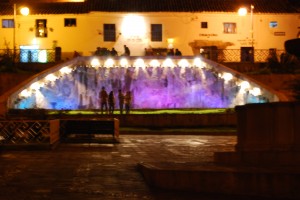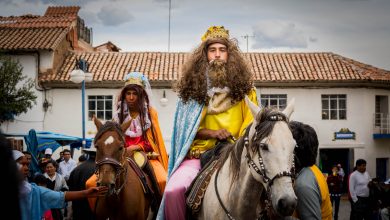San Blas, Cuzco’s Gem

San Blas, one of the most famous neighborhoods of Cuzco, is its most picturesque and offers a complete array of services to the tourist, including good food. Not only does it contain streets of Inca origin that look like they belong in a story about Don Quixote’s Spain, it promises a wide range of hotels from the most pricey to the least expensive, a variety of cuisine, and a rich cultural life.
In its streets and plazas, San Blas tells its history. One of the ancient twelve neighborhoods of Inca Cuzco, San Blas was known as T’oqocache. Garcilaso Inca de la Vega, using a different variant of the name, discusses its meaning in his famous Royal Commentaries of the Incas where he called T’oqocachi “a very large ward.”
The meaning of this compound I do not understand. Toco is “window” and cachi “salt for eating,” so that according to the rules of the language it ought to mean “window salt” : I cannot understand what is intended unless it is a proper noun and has a different meaning which I do not know. In this ward stood the primitive building of the convent of St. Francis.
Nowadays, the common meaning given is t’oqo “depression” and cachi “salt” to describe what is assumed to have been a hole from which salt was mined. The Spanish, and perhaps Garcilaso though a Cuzqueño, confused the consonants that distinguished t’oqo and toco.
At the time, T’oqocachi rose from the city of Cuzco, bounded by the Tullumayo River, in a series of stepped terraces that were both agricultural and contained significant shrines along the road, one of the four major highways leaving this center of an extensive empire, that lifted people up to the plateau by Sacsayhuaman and took them along an Inca highway to Antisuyo, the northern jungle lowlands..


In colonial times Viceroy Toledo had a small chapel built in what is now the district’s main plaza in order to catechize T’oqocachi’s people. The Church of San Blas, now famous for its artwork and its delicately carved altar, probably occupies the spot where an Inca temple to the god Illapa, lightning, rose that was related to Pachacutec Inca.
Spaniards found in this temple the mummy of the great Inca ruler — whose massive modern statue greets tourists as they come into the city from the airport and who is known for laying out the plan of the Inca city while massively expanding the empire — along with his wauque, his brother — a gold statue — called Inti Illapa. This image joined the names for the sun (whose worship Pachacutec brought to the Incas) and the powerful and ancient god lightning in one.
In a similar fashion, every street in San Blas holds a part of the neighborhood’s history.
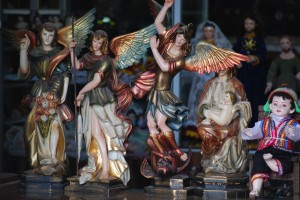
Today, San Blas is known as the artisan’s neighborhood, not just because it holds one of the most famous works of wood carving done by Cusqueño hands, the Pulpit of san Blas, but because it is also a stronghold of artisans who for years have made known their abilities in sculpture and painting. The Mendivil family, among others, keeps alive this rich tradition and has several shops.
This prize winning family has a unique style of longed necked figurines which has developed a new and intriguing style of popular religious art in Cuzco that joins with it rich artistic past. They are modern masters.
San Blas is one of the most visited places in Cuzco by the full variety of tourists. As a result, it not only is a traditional neighborhood of the city with its own heritage and culture, it is also extremely cosmopolitan.
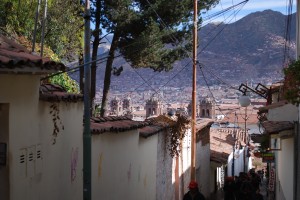
From San Blas’ slopes and the canyon to its side one can appreciate the widest panoramic view of the city’s colonial core. As a result within it are concentrated a majority of its hotels of various categories (hoteles, hospedajes, casas familiares, backpackers). The concentration of guest rooms also leads to a large demand for restaurants, cafés, lounge bars, etc, which offer a great variety of cuisines from all over the world, as well as Peruvian novo-andina and traditional dishes.
For example, La Caverne del Oriente specializes in French Cuisine, and by it The Meeting Place does American, while just up the steps Korma Sutra emphasizes curries.
It is not solely the view or the comfort of the place, but it is that all together they make San Blas a magical place which projects good energies towards its visitors. They feel a pleasing and tranquil ambience which leaves them surprised and touched by it all.
During the day San Blas displays for its guests many stores, such as jewelry shops, local handicraft shops of amazing quality though modestly priced, as well as art galeries, one of the larger concentrations of art in Cuzco.
On Saturday afternoons a handicraft market springs up on the charming Plazoleta de San Blas by the church of the same name.
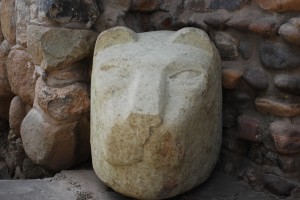
If we walk through the surrounding neighborhoods we can appreciate their beauty and majesty that stems from the colonial architecture. Given the beauty it is not surprising that this is a place where people come up to you, start a conversation, perhaps offer you their handicrafts in a firendly fashion. You can sit at an outdoor table and share a drink with your companions, while enjoying the treasure that San Blas is. You will want to take lots of pictures to share the sights of San Blas with your family and friends at home.
When night approaches, San Blas does not stop surprising us. It has a vivid and varied night life with music pouring from its bars accompanied by the voices of young men and women inviting you to come in and enjoy the salons and discoteques. Not only does San Blas have a range of places to enjoy for those who wish to have unforgetable memories, it has many places where you can enjoy a good drink accompanied by the music of the best bands during Cuzco’s “happy hours”.
During the high season( from April through October) this neighborhood fills with people and the hotels and restaurants are full. Because Cuzco’s municipality organizes many events during this season, such as the presentation of live music in the Plazoleta, the neighborhood feels like it is in fiesta. At night, the music, the people, and the rushing fountain with its many colors make this an incredible scene.
Even though San Blas is famous and well recognized by numerous visitors, it has not stopped giving its best to travelers. For that reason, if you come to Cuzco you must visit the neighborhood of San Blas which awaits you with all its charm and warmth.
By day San Blas is magical and enchanting while by night, cosmopolitan and tempting.
